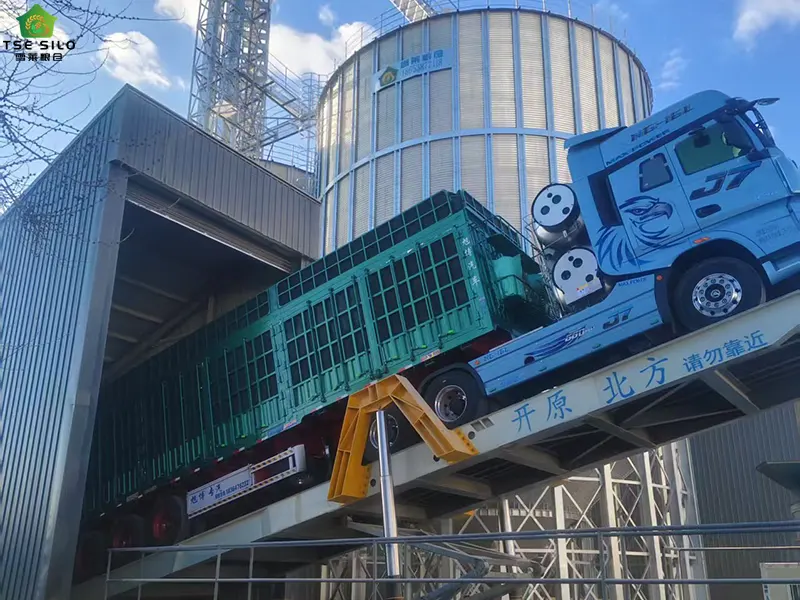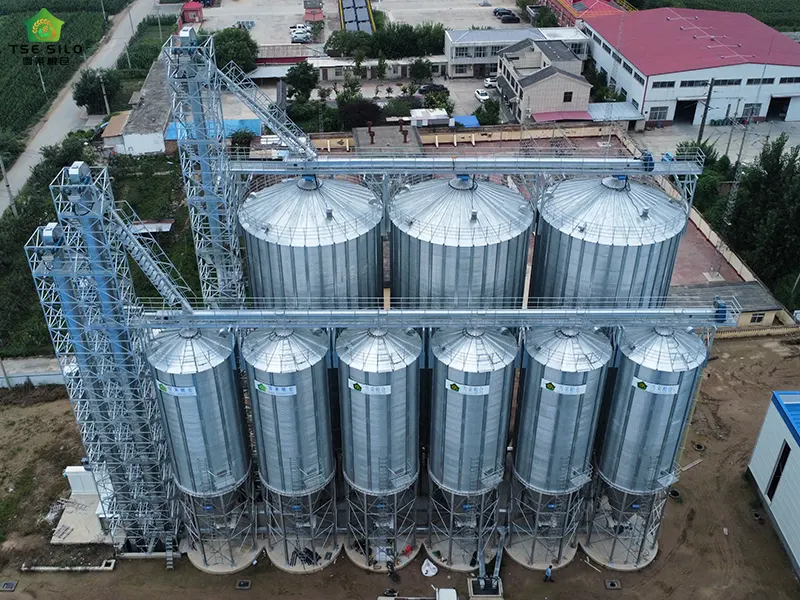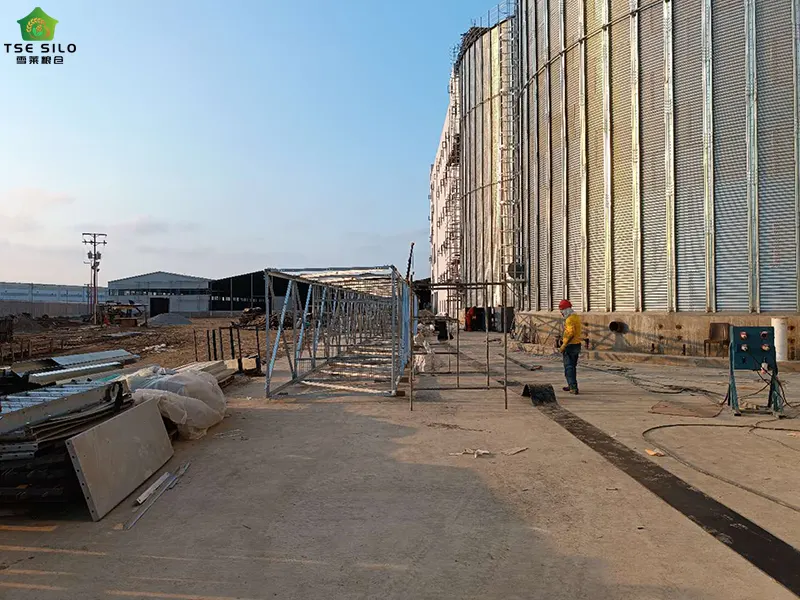The White Dew season has passed, and the autumn grain harvest is in full swing. The golden color of the grain brings the joy of a bountiful harvest. After the grain is harvested, it's time to store it in the warehouse. As managers of grain silos, we must be fully aware of the grain storage process and precautions. Only by doing so can we ensure the safe and timely storage of grain. Today, we will explain the basic steps and key control points for grain storage in flat bottom silo.
Grain storage in flat-bottomed steel silos is the first and most critical step in warehouse management, directly determining the safety and stability of subsequent grain storage. The following are the key points to note when storing grain in steel silos, divided into three stages: before storage, during storage, and after storage.


I. Pre-Storage Preparation
The core of this stage is a "physical examination" and "preparation" to ensure that both the silo and the grain are in optimal condition.
1. Empty Silo Inspection and Cleaning
- Interior Inspection: Thoroughly inspect the silo walls, roof, manholes, ladders, and other areas for rust, deformation, and, in particular, cracks or fissures in welds. Check the integrity of the anti-corrosion coating (if any) on the interior walls. Repair any detached grain immediately.
- Binding Cleaning: Remove all dust, impurities, insect eggs, residual grain, and microorganisms from the silo. If necessary, perform an empty silo disinfection to prevent cross-infection.
- Airtightness Check: This is particularly important for controlled atmosphere silos. Check the sealing strips on all doors, windows, and openings for aging or loss to ensure proper airtightness within the silo, which is essential for effective fumigation and controlled atmosphere (CA) operation.
2. Equipment Inspection and Commissioning
- Conveying System: Check the proper operation of equipment such as elevators, conveyors, scrapers, and chutes. Clean any residue inside the equipment to prevent contamination of incoming grain.
- Dust Removal System: Check the proper operation of fans and dust collectors to ensure effective dust control during silo entry, ensuring operational safety and the environment.
- Weighing Equipment: Calibrate scales or flowmeters to ensure accurate measurement of incoming grain for easier management and accounting.
- Grain Condition Monitoring and Control System: Check that all temperature and humidity sensors are functioning properly, data collection is accurate, and wiring is intact. These sensors are the "eyes" of the grain silo and must be calibrated in advance.
- Ventilation System: Check that the fan can start and stop normally and that the air ducts are clear and free of debris to prevent blockage.
- Other Equipment: Ensure that equipment such as primary cleaning screens and iron removers are functioning properly and effectively remove large impurities and metal impurities.
3. Grain Quality Control
- Source Control: Before grain is loaded for shipment, it is best to conduct a preliminary inspection at the production site or port. Unqualified grain will not be accepted.
- Pre-Warehouse Inspection: Upon arrival, grain must be sampled and tested on-site. Key indicators include:
- Moisture Content: This is the most important indicator and must be below the safe storage moisture standard (e.g., ≤14% for corn, ≤12.5% for wheat). High moisture content is a root cause of heat and mold.
- Impurity Content: Excessive impurities can affect ventilation uniformity and create a breeding ground for insects and mold. This should be strictly controlled (generally ≤1%).
- Imperfect/Damaged Kernels: These kernels are more susceptible to mold and insect infestation.
- Pest Infestation: Check for live pests or eggs.
II. Operations During Storage
The key to this stage is uniformity and cooling, ensuring proper grain distribution and minimizing automatic grading and breakage. This is also the core execution phase, crucial for controlling grain quality and ensuring operational safety.
1. Sampling Inspection:
- Upon arrival of the grain truck, quality inspectors first collect representative samples.
- Key indicators such as moisture, impurities, color, and odor are quickly tested.
- We strictly implement a "one truck, one inspection" policy, rejecting unqualified grain or subjecting it to required processing (such as airing) before storage.
2. Weighing:
- Weigh qualified trucks and record the gross weight. After unloading, the tare weight is measured to calculate the net weight.
3. Primary Cleaning and Impurity Removal:
- Grain undergoes primary cleaning through a cleaning screen, effectively removing large impurities (such as straw and paper) and small impurities (such as mud and fine particles).
- This is a critical step in ensuring the purity of incoming grain and reducing hot spots.
4. Silo Loading and Distribution:
- Mechanized Silo Loading: Grain is delivered to the silo roof via conveyor equipment.
- Uniform Distribution: Automatic spreaders or manual operation ensure even distribution of grain within the silo to avoid severe auto-grading (where heavy impurities and broken grains are concentrated in the center, while light husks are distributed around the periphery).
- Reducing Grain Breakage: The grain drop height is appropriately designed, and pressure relief devices are used to minimize grain breakage.
- Using a Spreader: This is a critical piece of equipment for silo loading. A spreader or central spreader must be used to evenly distribute grain from the center to the periphery.
- Avoid Auto-Segregation: Feeding grain directly from a single point without using a distributor can cause severe auto-segregation: heavy, full grains will roll outward, while light, impurities, and broken grains will concentrate in the center, forming a "danger triangle" prone to mold.
- Multiple Feeding Points: Large silos may consider multiple feeding points to further ensure uniformity.
- Controlling the Drop Height: Minimize the drop height to reduce grain breakage caused by impact.
5. Process Quality Monitoring:
- Staffing: Unattended grain loading is strictly prohibited. Dedicated personnel must monitor the operating status of conveying equipment, dust removal equipment, and distributors.
- Preventing Blockages: Observe grain flow at all times to prevent equipment blockage or overflow.
- Rechecking Grain Quality: During the grain loading process, samples should be regularly rechecked (e.g., every two hours) for moisture, impurities, and other indicators to ensure consistent quality. If quality fluctuations are detected, the cause should be promptly identified.
6. Safe Operations:
- Entering the silo during operation is strictly prohibited: No personnel are allowed inside the silo! The movement of grain inside the silo can cause drowning accidents and is extremely dangerous.
- Personal Protection: Mechanical equipment must be equipped with protective shields on transmission parts, and personnel must wear labor protection equipment.
- Electricity and Fire Prevention: Pay attention to electrical safety and fire prevention.
- Preventing Dust Explosions: The dust concentration inside the silo is high and can easily explode when exposed to open flames or sparks. Ensure all equipment is explosion-proof, prohibit fireworks, and ensure effective dust removal systems.
- Mechanical Injuries: Keep personnel away from operating conveying equipment.
- Confined Space Operations: If inspection is required inside the silo, strictly follow confined space operation procedures, including ventilation, oxygen and toxic gas monitoring, safety ropes, and dedicated external supervision.


III. Post-Warehousing Management
Once the grain is fully loaded, the work begins. The key is "stability" and "monitoring."
1. Leveling the Grain Surface
- After storage, level the grain surface to avoid obvious peaks or slopes, creating uniform conditions for subsequent ventilation and fumigation operations.
2. Installing the System and Sealing
- Activating the Measurement and Control System: Ensure all sensors are covered by the grain and begin continuous monitoring of temperature changes at all levels and points.
- Seal the Silo: Close and seal all access holes, inspection doors, and vents. For controlled atmosphere storage, perform a pressure test to ensure airtightness.
3. Initial Ventilation
- Timely Ventilation: After storage, grain accumulates heat due to respiration and mechanical operation. Initial ventilation should be performed when the ambient temperature and humidity are appropriate (usually at night or during cool, dry weather). This aims to reduce heat, dissipate moisture, balance the internal temperature of the grain pile, and prevent condensation.
- Preventing Condensation: Ventilation should be strictly avoided in weather where high-temperature grain meets cold air, which could cause condensation (such as rainy days or high temperatures at noon).
4. Establish a File
- Detailed records are kept of all incoming grains for this warehouse, including: variety, quantity, origin, year of production, date of entry, quality data such as initial moisture, impurities, and imperfect grains, as well as the person responsible for receiving the grains. Establishing comprehensive files is the cornerstone of refined management.
Summary: Critical Control Points
| Phase |
Core Objectives |
Key Considerations |
| Before Storage |
Ensure Safety and Compliance |
1. Clean and disinfect empty silos
2. Check silo structure and airtightness
3. Ensure all equipment is functioning properly
4. Strictly test grain for moisture and impurities; reject grain that does not meet standards |
| During Storage |
Evenly distribute grain and minimize damage |
1. Use a spreader to prevent automatic grading
2. Control grain drop to reduce breakage
3. Dedicated personnel on duty and conduct random inspections during the process
4. Strictly adhere to safety regulations and implement explosion and dust prevention measures |
| After Storage |
Stabilize grain conditions and establish records |
1. Level grain surface
2. Seal silos and activate measurement and control systems
3. Promptly conduct initial ventilation to reduce temperature and moisture
4. Establish complete storage records |
Following the above precautions can effectively ensure the safe and high-quality entry of grain into steel silos, laying a solid foundation for subsequent long-term safe storage.
The above are the basic steps and key control points for loading grain into flat bottom silo. We hope that this will be helpful for future grain loading operations.
Written by
Shandong Shelley Grain Steel Silo Co., Ltd
Editor Jin
WhatsApp : +86-18653877118
Email : shelley@cnshelley.com






